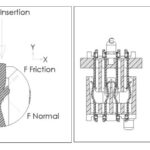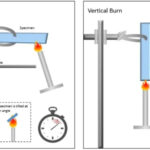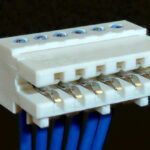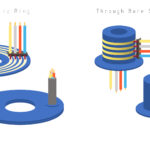Contact security and reliability are important considerations when designing heating ventilation/air conditioning (HVAC) systems and other equipment for use in harsh environments, like outdoors or in industrial facilities. Well-established standards like RAST connectors provide a good alternative, but some applications demand more. Challenges include environmental sealing, contact retention, position optimization, and locking power connectors together to prevent accidental disconnects.
This FAQ reviews a range of options including common connector locking mechanisms, options for environmental sealing, modular systems for terminal locking and contact position control, and locking IEC power connectors that can be used with standard power inlets. It closes by presenting an approach for using enhanced finite element analysis to model and evaluate contact reliability.
A variety of locking mechanisms are available, especially for circular connectors. Some implementations can also provide protection against harsh environments, and many can withstand significant levels of shock and vibration. Examples include:
Bayonet couplings use three equally spaced pins on the receptacle shell of a circular connector that inserts into corresponding ramps milled into the coupling nut. It can provide varying levels of environmental protection, plus a simple twist ensures a reliable connection.
Screw couplings are the most secure, though not the easiest to use. They are available with coarse and fine thread, depending on the pin and connector sizes. Screw couplings can provide high levels of protection against ingress of water, dust, and other contaminants.
Push-pull coupling prevents the connector from unintentionally disconnecting during use. Push-pull connectors are suited for applications where a locking connection and signal integrity are important considerations.
Breakaway couplings are available in sealed and unsealed versions. They are electrical safety components and disconnect immediately in response to moving or rotating components to prevent tangling or exposure to high tensile loads. They are usually circular connectors, but noncircular versions are also available.
Contact alignment and retention
Various position assurance designs are available to support contact alignment and retention, especially for conventional crimp/snap connectors that can be challenged with contact back-out issues. The two most common solutions are connector position assurance (CPA) and terminal position assurance (TPA).
CPA refers to a secondary locking mechanism that ensures that connector mating is correct. A common implementation includes a latch that slides under a retention clip on the mating plug securing the connectors in the mated position. It only latches when the connector is correctly mated. A primary latch must be pressed to release the retention clip and allow unmating.
TPA is designed to prevent contact back-out. TPA solutions can be classified as primary lock reinforcement (PLR) or independent secondary lock (ISL). Both are designed to prevent the withdrawal of the terminals from the connector, but the ISL generally acts to supplement or reinforce the PLR. Some secondary locks also serve as strain reliefs.
CPA and TPA mechanisms can be integrated with the connector or supplied as optional accessories. In addition to the basic CPA and TPA solutions, many connectors also include a latching mechanism that produces an audible click when the connector is properly mated (Figure 2).

Environmental protection
While there are several industry-standard approaches to providing environmental protection for circular connectors, environmental protection for noncircular connectors is less standardized but equally important.
Consumer and commercial HVAC systems and various types of communications and industrial equipment can benefit from environmental protection options like O-rings or protective caps and completely sealed interconnect systems rated for IP67 with pre-installed seals for dust-tight and weatherproof (submersible in up to one meter of water).
Protective rubber caps are available for wire-to-wire connector systems that provide IP51 protection (Figure 3). These caps are designed to provide access for inspections to ensure quality installations as well as provide protection against water, foam, and dust-debris ingress. They are designed for use in home appliances, commercial and residential HVAC, commercial vehicles, and industrial automation applications.

Power connections
Improving connector reliability for power contacts can be an important consideration to prevent accidental disconnects and mitigate the effects of shock and vibration. Locking connectors are available for standard IEC power inlets that can eliminate the need for separate retaining clips. One design includes an integrated locking system that requires no modification to existing IEC inlets or EMI filters. It locks to the ground pin of standard IEC inlets and provides a dual-locking system that prevents accidental disconnects. It’s designed for use in data centers, power distribution units, industrial equipment, medical devices, and other critical power applications.
The locking system has a typical tensile force of 200 N, and it’s recommended to use it with flange mount filters or inlets. Safety certifications are available for Australia, Canada, Europe, and the U.S. Some features include:
- It is rated current up to 10 A (C13 plug), up to 15 A (C13P plug), and up to 20 A (C19 plug).
- Its maximum pin temperature is +70 °C.
- Various power line plugs are available for international applications.

Enhanced finite element modeling
Several approaches are used when analyzing the reliability of connector designs including physics of failure (POF) and finite element (FE) analysis, in addition to the traditional statistics-based methodologies. While these approaches are useful, they don’t consider relationships between the structure and material and the reliability of the connector.
A new methodology has been proposed for reliability evaluation of connectors. This approach includes three modules, each of which evaluates one aspect of connector reliability including the initial state after function realization, the degradation behavior over time, and the anti-overload performance. To test the results of the proposed methodology, the substrate material on an existing blade-spring connector was replaced with a newer copper alloy called Cu-20Zn-1.5Ni-0.34Si. The analysis indicates that connector reliability using the new allow can be improved by increasing the insertion depth of the blade and using lubrication or decreasing the contact normal force.
As part of the performance degradation evaluation, a model was developed for assessing reliability under thermal diffusion mechanisms, and the model results were verified with experimental data. The model can quantitively determine the thickness of the oxidation film on the contact surfaces, which enables the calculation of the contact resistance to determine if the design is sufficient to meet the performance criteria.
FE analysis on a 1/4 model was implemented using an Ansys Workbench (Figure 4). By adding material performance considerations into contact modeling, this effort has developed a systematic approach for the reliability evaluation of contacts that may be useful in helping connector designers model expected connector performance and optimize contact reliability. Advantages claimed for this new design methodology include:
- It can be systematically applied to the entire design process including the integration of functional design and reliability analysis.
- It considers multiple design factors and degradation mechanisms and their interrelationships.
- It combines POF and FE quantitative methodologies and adds a method for the inclusion of material selection criteria with a quantitative thermal diffusion evaluation model that can speed up the connector and contact design process.

Summary
Contact retention and reliability are important in a range of applications from residential and commercial HVAC to industrial, communications, transport, medical, and mil/aero systems. There are different approaches for supporting reliable connector operation for circular and non-circular connectors including locking mechanisms, connector and contact position assurance designs, and various types of environmental protection. For reliable power connections, locking connectors are available that are compatible with standard IEC power inlets and EMI filter modules. Finally, a new approach has been proposed to speed the design of new connectors and contacts including both mechanical and materials design factors to ensure reliable operation.
References
A Systematic Approach for the Reliability Evaluation of Electric Connectors, Hindawi Journal of Electrical and Computer Engineering
Delivering Superior Protection and Performance for HVAC, Molex
Improving Appliance Connector Designs, TE Connectivity
Using IEC-Lock Power Cords with IEC Inlets and Filters, Schaffner
What Is Position Assurance?, Amphenol





Leave a Reply
You must be logged in to post a comment.